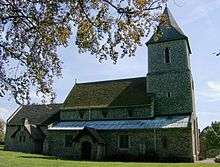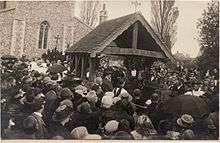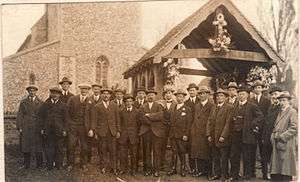St Leonard's Church, Sandridge
St Leonard's Church is in Sandridge, a village in Hertfordshire, England. It is an active Anglican parish church. The building is Grade II* listed: notable features include its chancel arch made from recycled Roman brick.[1]
| St Leonard's Church, Sandridge | |
|---|---|
 St Leonard's Church, 2009 | |
| Denomination | Church of England |
| Churchmanship | Broad Church |
| Website | http://www.sandridgechurch.org.uk/ |
| History | |
| Dedication | St. Leonard |
| Administration | |
| Parish | Sandridge |
| Deanery | Wheathamstead |
| Diocese | St Albans |
| Province | Canterbury |
| Clergy | |
| Rector | Revd Emma (Em) Coley |
| Curate(s) | Revd John Hillier |
History
Some sort of simple wooden church was probably made necessary in 796 when the Abbey of St Albans took possession of the Manor of Sandridge. However, the Domesday Book does not mention the existence of a church at Sandridge. The oldest surviving feature of the present church is possibly the semi-circular head of the arch between the Nave and the Chancel, although the date of this uncertain. One theory is that it dates from 946. The abbots of St. Albans are known to have had a stockpile of Roman brick, the material used.[2]

It was no later than 1119 that the church was consecrated and dedicated to St Leonard by Herbert de Losinga 1st Bishop of Norwich (he died in 1119) and that Sandridge became a parish.
The nave was enlarged and aisles were added between 1160 and 1180. On either side of the nave are three Norman arches. The church font is also thought to date from Norman times. The Early English pointed arch and the tower either built or re-modelled towards the end of the 13th century.
The stone screen was added to the wall between the Nave and the Chancel towards the end of the 14th century. It is richly ornamented on the eastern side but plainer on the west as here there was a carved wooden screen with Rood Loft and Rood above and an altar on each side of the archway into the Chancel. The Chancel was re-built and lengthened in 1399 and the squared headed perpendicular windows replaced the narrower Norman windows in the aisles. The south doorway was also built.

After the dissolution of the monasteries many valuable ornaments and fittings of the Church were removed and the church fell into neglect and decay. By 1638 the church was fitted with pews and the arrangement of these has lasted to modern times. A pulpit was erected on the south side of the nave, the remains of which can be seen in the prayer desks in the sanctuary. The tower collapsed in 1692 or 1693 and the church wardens reported that the rebuilding would cost seven hundred pounds. Nothing was done beyond boarding up the arch in the west end and clearing away some of the rubble.
The clerestory of the Nave and the roof were in a very bad state in 1710 but where patched up and made to serve until 1786. In 1786 the rotten walls of the clerestory were removed and the roof lowered and flattened out to rest on the Norman arches. Attic windows were put in and the wooden bell turret erected. Between 1836 and 1838 a tower was built. During 1886 - 1887 Mr William White restored the whole church to the state it exists in today. It cost £3800 and re-opened on 7 June 1887. The ring of bells was dedicated on 11 January 1890.
The organ was given by Mr & Mrs Kinder, Mr & Mrs Marten and Dr Griffith. Before the restoration it stood in the Chancel, then re-built under the Tower and in 1914 enlarged and re-built at the east end of the North Aisle. At the same time the Pulpit was moved to the north side of the Chancel screen and the Choir seated in the Chancel.
Lychgate
To the south of the churchyard is a Lychgate

"Erected to the Glory of God and in Grateful Memory of the men of this Parish who gave their lives in the Great War 1914-1918".
Dedication
The Lychgate was unveiled and dedicated in a ceremony on Sunday 24 April 1921 at 3pm.
- A detachment of the St Alban's Church Lads' Brigade will line the churchyard leading from the North door
- The Clergy and Choir will take up position on the inside of the Lychgate; the mourners immediately in front of it on the outside; the ex servicemen to the left and the school children to the right. The remainder of the congregation are asked to occupy the ground behind the mourners
The lesson was Revelation xxxi, 1-7 and read by the Reverend T. W. Lister
The Address was given by the Dean of St Albans the Very Reverend G W Blenkin
At the Lychgate itself the unveiling was by Colonel Henry Page Croft MP.
The final hymn sung by the children

O valiant Hearts Who to your glory came"
This was followed by the Benediction, then The Last Post a brief silence and the Reveille and the National Anthem.
The inscription on the gate

References
- St Leonard, Sandridge
- Stalley, Roger. Early Medieval Architecture, (Google Books link), Oxford University Press, USA, 1999, pp. 112-14, (ISBN 0-19-284223-4).
- H. R. Wilton Hall The History of Sandridge Church, St Leonard's Church Sandridge, 800th Anniversary.
- J. A. Cruikshank Some dates in the history of St Leonard's Church, Sandridge: a paper read at a meeting of the St Albans and Hertfordshire Architectural and Archeological Society, held at Sandridge, June 24, 1900
- The order of service Unveiling and Dedication of the Lychgate Sunday April 24, 1921
External links
| Wikimedia Commons has media related to St Leonard's Church, Sandridge. |
"St. Leonard's Church - Sandridge - Sandridge Parish Council". www.eastspace.net. Retrieved 2009-11-06. "St. Leonard's Church - Sandridge". Retrieved 2012-01-05.